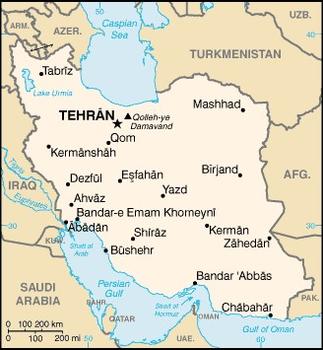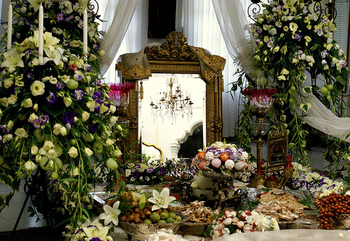Persian Wedding
Iran is a country of 70,472,846 (2007) people located in central Asia on the northeastern shore of the Persian Gulf and the southern shore of the Caspian Sea. Word Iran in modern Persian comes from the Proto-Iranian term Aryānā or Aryan which means "land of Aryans".
 Map of Iran
Map of Iran
Until 1935 the country was called Persia. Nowadays term Persian is usually used in the cultural sense. That is why the term Persian will be used in the rest of this article when talking about the weddings in Iran.
Shia Islam is the official religion. Still many of traditions present in local weddings have its origin in ancient Zoroastrian tradition.
Zoroastrianism or Mazdaism is the religion and philosophy based on the teaching of prophet Zoroaster. God worshipped in this religion is called Ahura Mazda.
Traditional Persian wedding has two parts. They are usually organized on the same day. The first part is called "Aghd". During the Aghd bride, groom and their guardians sign a wedding contract. It is tradition that the Aghd is set in the home of bride's parents or guardians.
The ceremony is organized in a room decorated with flowers. On the floor there is a spread called "Sofreh-ye Aghd" or "Sofreh Aghd." The spread is set facing east, in the direction of sunrise.
 Sofreh-ye Aghd or Sofreh Aghd
Sofreh-ye Aghd or Sofreh Aghd
Special piece of cloth is set under the spread. It is passed from mother to daughter or sometimes son. It is made of finest fabric - "Termeh" (Cashmere), "Atlas" (Satin with golden embroidery) or "Abrisham" (Silk).
Several objects are traditionally put on the "Sofreh-ye Aghd". They are "Aayeneh-ye Bakht" or the mirror of fate and two candelabras on each side of the mirror. These objects are symbols of light, fire, goodness and wisdom.
In the centre of the "Sofreh-ye Aghd" there are opened copy of Quran, a prayer rug and a prayer kit.
The wedding ceremony starts with the arrival of guests. Couple's guardians or the elders of the family guide them to their seats. When everyone is seated the groom arrives. He sits at the head of "Sofreh-ye Aghd". Then the bride enters the room and joins the groom. She has a veil on her face. She sits left of the groom. When seated she removes her veil. The first thing the groom sees in the mirror is the face of his future bride.
"Sini-ye Aatel-O-Baatel" or a tray of herbs and spices is also prepared. They suppose to protect the couple from the evil eye, witchcraft and all the evil spirits.
The tray includes seven elements in seven colours. Poppy Seeds or "Khash-Khaash" should break spells and witchcraft. Wild Rice or "Berenj", Angelica or "Sabzi Khoshk " and Salt or "Namak" should "blind" the evil eye. Nigella Seeds or "Raziyaneh", Black Tea or "Chaay", Frankincense or "Kondor" are the "tools" that ward off the evil spirits.
"Tokhme Morgh" and "Ajil", meaning eggs and nuts (pistachios, walnuts, almonds and hazelnuts), are also there. They are the symbols of fertility.
A bowl filled with coins is put as it symbolizes the wish for wealth in the life. Different sweets are put as symbols of sweet life. They are shared among the people present at the ceremony.
A cup of rose water made from the Persian rose "Gol-e Mohammadi" is set to perfume the air.
The guests throw sugar onto the couple. The sugar is taken from two sugar cones called "Kalleh Ghand". It is done as a wish for the joyous, sweet life.
Also there is a special scarf or shawl that is held over the couple during the ceremony. It is held by the married women from the bride's family. Religious part of the wedding ceremony is performed according to Islam with readings from the Quran and blessings like the "Kitbah".
The second part of Persian wedding is called "Jashn-e Aroosi " or the wedding reception. It lasts from 3 to 7 days. At the reception people dance "Raghse Chaghoo" or "Knife dance". When dancing the bride and groom try to get the knife so they could cut the wedding cake. First dancer holding knife asks the couple for some money. The knife is then passed to the next dancer. After some time the couple finally gets the knife.